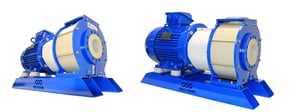
Mechanical seal selection
Crest offers many types of pumps with a variety of arrangements including magnetic drive, seal less and mechanical seals.
There are several types of mechanical seal and whilst Crest can fit specific seal if required, it is fair to say that 99% of seals fit under three separate categories for our mechanical seal selection briefing.
Introduction
Crest offers many types of pumps with a variety of arrangements. These include magnetic drive, sealless and mechanical seals. Dependent upon the operating conditions factors such as liquid, temperature, solids content fluid density (S.G.). As well as the pump installation itself often means that a mechanically sealed pump is the obvious choice. There are several types of mechanical seal and whilst Crest can fit specific seal if required, it is fair to say that 99% of seals fit under three separate categories.
Single Internal Mechanical Seals (MSH Type)
The single most common seal type and consists of a single large 316 stainless steel spring. This surrounds a rubber bellows and fits with a silicon carbide stationary seat and rotating face. We fit Silicon carbide as a standard material but other material combinations such as carbon and ceramic are available. The rubber bellows is available in either EPDM or Viton though, again, other materials are available. The seal mounts internally so the 316 stainless steel spring and other metal components are to the pumped liquid exposed, as this can be a limiting factor it is important to ensure to select the correct materials. Please refer to Crest if in any doubt.
Double Mechanical Seals Requires Pressurised External Flush (Double MSH/MSH Type)
For liquids that contain solids, especially abrasive, or have a tendency to crystalize a double mechanical seal is essential. This arrangement consists of two MSH seals fitted back-to-back within a seal chamber. This will have a separate pressurised flush at a pressure of one bar above the maximum discharge pressure of the pump. The inboard seal (the seal nearest the pump) will see the pumped liquid but only the rubber bellows, face, and seat; the spring and metal components are left to the flush liquid exposed. Using the outboard seal to seal the chamber. The pressure is always higher within the seal chamber. Thus, ensuring that only clean liquid is at the critical area across the face. Also meaning that solids and / or crystals cannot damage the face or seat. The pressurised flush found from either an external source or by thermosyphon sealing system such as the Crest SS24 sealing system. A specific advantage of using double seals is that the pump protected against dry running.
Single External Mechanical Seals (MSC Type)
A PTFE mechanical seal with a machined bellows mainly used for handling clean acids and scrubber liquors. The only materials in contact with the pumped medium is PTFE and silicon carbide. (rotating face and stationary seat). Furthermore, this seal is perfect for handling highly corrosive acids etc. Controlled pressure of the face against the seat is affected by a single external spring surrounding the PTFE bellows. MSC seals are simple to set up and maintain.
We often post articles and other news on our LinkedIn page, so please go and follow to keep up to date or for any pump queries you may have please contact us.






